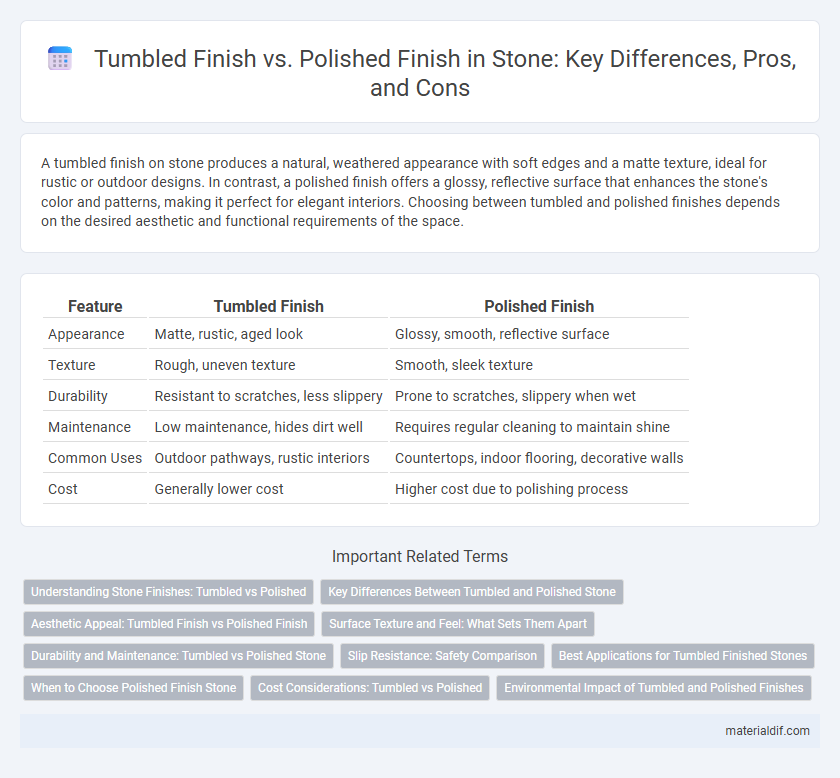A tumbled finish on stone produces a natural, weathered appearance with soft edges and a matte texture, ideal for rustic or outdoor designs. In contrast, a polished finish offers a glossy, reflective surface that enhances the stone's color and patterns, making it perfect for elegant interiors. Choosing between tumbled and polished finishes depends on the desired aesthetic and functional requirements of the space.
Table of Comparison
| Feature | Tumbled Finish | Polished Finish |
|---|---|---|
| Appearance | Matte, rustic, aged look | Glossy, smooth, reflective surface |
| Texture | Rough, uneven texture | Smooth, sleek texture |
| Durability | Resistant to scratches, less slippery | Prone to scratches, slippery when wet |
| Maintenance | Low maintenance, hides dirt well | Requires regular cleaning to maintain shine |
| Common Uses | Outdoor pathways, rustic interiors | Countertops, indoor flooring, decorative walls |
| Cost | Generally lower cost | Higher cost due to polishing process |
Understanding Stone Finishes: Tumbled vs Polished
Tumbled finish stone features a naturally worn, matte surface achieved by tumbling stones with abrasive materials, enhancing texture and suitability for rustic or outdoor spaces. Polished finish stone undergoes a grinding and buffing process, resulting in a glossy, reflective surface that highlights color variations and increases durability, making it ideal for indoor applications like countertops and flooring. Choosing between tumbled and polished finishes depends on desired aesthetic, maintenance preferences, and the specific use environment of the stone.
Key Differences Between Tumbled and Polished Stone
Tumbled finish stone features a rough, textured surface created by tumbling stones with abrasives, resulting in a natural, aged look ideal for rustic or outdoor applications, whereas polished finish stone undergoes a grinding and buffing process to achieve a smooth, reflective, and glossy surface suitable for elegant interiors. The porous nature of tumbled stone enhances slip resistance and hides imperfections, while polished stone's dense, non-porous surface offers superior stain resistance but can be slippery when wet. Maintenance requirements differ as tumbled finishes may trap dirt more easily and require sealing, whereas polished finishes are easier to clean but prone to showing scratches and etching.
Aesthetic Appeal: Tumbled Finish vs Polished Finish
Tumbled finish stone offers a rustic, weathered aesthetic with soft edges and a matte surface that enhances natural texture and earthy tones. Polished finish stone provides a sleek, glossy appearance, intensifying color richness and creating a reflective, smooth surface ideal for modern and luxurious designs. Choosing between tumbled and polished finishes depends on the desired visual impact, with tumbled emphasizing natural ruggedness and polished highlighting elegance and refinement.
Surface Texture and Feel: What Sets Them Apart
Tumbled finish stone offers a textured, rustic surface with a matte appearance, creating a natural, weathered feel that enhances grip and reduces slipperiness. Polished finish stone provides a smooth, glossy surface with high reflectivity, emphasizing elegance and depth of color while feeling cool and sleek to the touch. The choice between tumbled and polished finishes significantly impacts both the tactile experience and visual dynamics of stone applications.
Durability and Maintenance: Tumbled vs Polished Stone
Tumbled stone features a rougher, matte surface created through a tumbling process that enhances durability by minimizing visible wear and scratches, making it ideal for high-traffic areas requiring low maintenance. Polished stone offers a glossy, reflective finish that accentuates color and pattern but is more prone to scratches and etching, necessitating regular sealing and careful cleaning to maintain its pristine appearance. Choosing between tumbled and polished stone depends on balancing the desired aesthetic with the level of durability and maintenance preferred for surfaces like countertops, flooring, or walls.
Slip Resistance: Safety Comparison
Tumbled finish stone provides superior slip resistance due to its textured surface, making it ideal for outdoor pathways and wet areas. Polished finish stone, while visually striking with its smooth and glossy appearance, tends to be more slippery when wet, posing a higher safety risk. Choosing tumbled finish enhances safety through increased traction, crucial in environments prone to moisture.
Best Applications for Tumbled Finished Stones
Tumbled finish stones offer a soft, weathered look ideal for rustic and natural design themes, making them perfect for outdoor landscapes, garden pathways, and decorative rock walls. Their textured surface provides enhanced slip resistance, which is beneficial for pool surrounds and patio flooring. Tumbled stones are also commonly used in creating vintage-style interiors where a matte, aged appearance enhances the aesthetic appeal.
When to Choose Polished Finish Stone
Polished finish stone is ideal for areas that benefit from a sleek, reflective surface, such as countertops, bathroom vanities, and decorative walls, enhancing natural colors and patterns. This finish provides a smooth, non-porous surface that resists stains and is easier to clean, making it suitable for high-traffic and moisture-prone spaces. The durability and glossy appearance of polished stone elevate aesthetic appeal while maintaining longevity in both residential and commercial applications.
Cost Considerations: Tumbled vs Polished
Tumbled stone surfaces generally cost less than polished finishes due to lower processing time and simpler machinery requirements. Polishing demands high precision and extended labor, resulting in higher material and installation expenses. Choosing between tumbled and polished stone depends on budget constraints and desired aesthetic impact.
Environmental Impact of Tumbled and Polished Finishes
Tumbled stone finishes create a weathered, natural appearance through abrasion, using less energy-intensive processes compared to polished finishes, which require extensive grinding and buffing with chemical agents. The environmental impact of tumbled finishes is lower due to reduced water consumption and minimal use of hazardous polishing compounds. Polished finishes, while providing a glossy and reflective surface, contribute to higher carbon emissions and greater resource depletion throughout production.
Tumbled Finish vs Polished Finish Infographic

 materialdif.com
materialdif.com